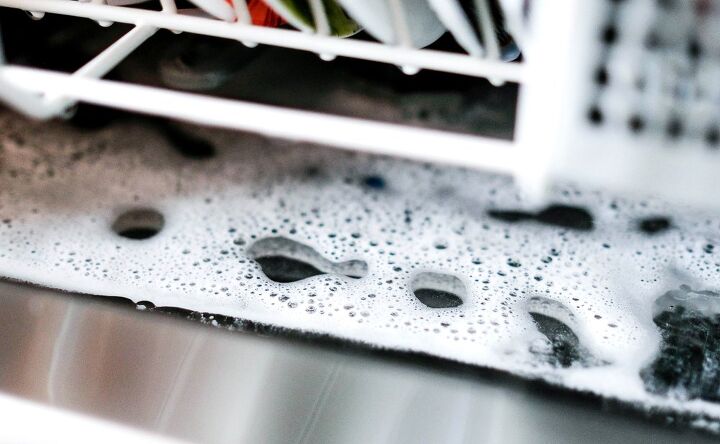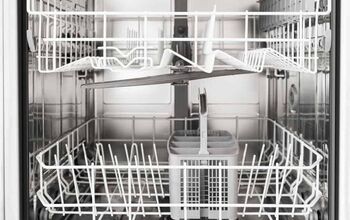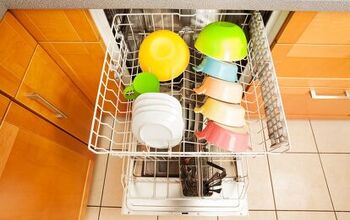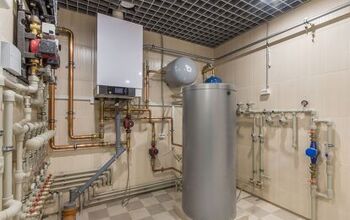Dishwasher Filling With Water But Not Spraying? (Possible Causes & Fixes)

Nothing is more frustrating than finding dirty dishes, even after your dishwasher has run a full cycle. Not only can dirty dishes cause you to spend more time with household chores, but they can be costly, adding unnecessary electricity and water usage to your monthly bill. Having a dishwasher that fills with water, but doesn’t spray the water, can mean your dishes are not getting fully cleaned or sanitized.
If your dishwasher is filling with water but not spraying, there could be multiple reasons for the malfunction. Sometimes a simple blocked spray arm caused by overloading the dishwasher may be to blame. In other cases, a more serious problem like a malfunctioning circulation pump or overfill switch could be preventing your dishwasher from spraying.
There are some easy steps to check your dishwasher to try to diagnose the problem. Most repairs are easy and can be completed by the average homeowner. A technician may be called to help fix a broken circulation pump or overfill switch in rare cases. By determining the cause of your malfunctioning dishwasher, you’ll be able to save time, money, and frustration.
Do You Need Appliance Repair Services?
Get free, zero-commitment quotes from pro contractors near you.

Is Water Getting to the Dishwasher?
One of the most common reasons water is not spraying is that there is not enough water filling into the dishwasher when you start a cycle. When the dishwasher is first started, you should hear water flowing into the appliance. Even though new dishwashers are quieter, you’ll be able to hear water after a few minutes.
If there is no water, or limited water filling into the tub, the issue is a water supply problem. There could be several reasons why water supply is an issue, ranging from a potential leak to inadequate water pressure. If you have checked and no issues have presented themselves, the problem may have to do with your water inlet valve.
What Is a Water Inlet Valve?
A water inlet valve works to allow water to flow into the dishwasher at the right time. Sometimes, if the valve is malfunctioning, limited water is allowed into the unit, giving enough water pressure to make it to the sprayers. Luckily, replacing the water inlet valve is easy and can be completed by a savvy DIY homeowner in just a few minutes.
Check out our guide: Dishwasher Float Not Operating Properly?
What About the Overfill Switch?
There is an overfill switch within the dishwasher that works as a failsafe to prevent your dishwasher from overflowing. It works by sensing water in the dishwasher and then shutting off the flow once a suitable level has been reached. If the switch is not working properly, it could prevent the tub from filling to the right level, which may not be enough to power the spray arms. Sometimes, simply replacing the overfill switch is enough to fix your dishwasher.
Are You Overloading the Dishwasher?
Putting too many dishes into your dishwasher can cause the dishwasher to fill with water but prevent the spray arms from spraying. If you have a dish or a cup blocking the path of the spray arms or the spray nozzle, it can prevent water from fully entering and moving throughout the machine.
Always be sure to load the dishwasher properly. Overloading the dishwasher, especially with too many utensils, can make it more difficult for the dishwasher to clean. Even the smallest cup can move or shift, preventing a free spray path. If you are experiencing trouble with a full dishwasher, try to reorganize the dishes or take a few out and run the cycle again.
Is There Enough Water Pressure?
If the water pressure is too low, it could not be powerful enough to generate the flow needed for the spray arms. It could also prevent the tub from fully filling. Low water pressure could be caused by several sources, including a possible leak in the water lines or a malfunctioning water valve.
After investigations prove that there is no leak, you may have an issue with simply low pressure within your house. Try to only use one appliance in the home that requires water at any given time. If you are running the washing machine while doing a load of dishes, your house may not be able to provide water pressure and flow to both adequately. If your dishwasher still does not have enough pressure traveling to the appliance, you may need to replace or adjust the internal float switch in the machine.
Could My Spray Arm Be To Blame?
The spray arm is responsible for distributing water throughout the appliance to help ensure your dishes are cleaned. A malfunctioning spray arm can be the leading cause of water not spraying throughout your dishwasher, despite filling completely. Some common issues with the spray arm include:
- Blocked Spray Arm – If you are filling your dishwasher packed to the gills every time, you may be inadvertently blocking the path of your spray arm. When the arm cannot completely rotate, it won’t work, and water will not move throughout the dishwasher.
- Clogged Spray Arm – As you use your dishwasher, tiny food particles can become jammed in the spray holes of the spray arms. When this happens, water cannot shoot out of the holes. It is best to unclog the holes manually with a toothpick or allow the arms to soak in a cleaning solution to dissolve the food waste.
- Broken Spray Arm – As dishwashers age, hard water can start to take its toll. Spray arms can become damaged and cracked from repeated use or hard water. If you notice cracks in your spray arm, water may be leaking through the gap instead of shooting out through the spray holes. In this case, you’ll need to replace the spray arm.
Can the Circulation Pump Go Bad?
The circulation pump is a necessary part of the dishwasher that helps to circulate water through the tub, pumping water up to the spray arms. If your dishwasher is filling with water but not spraying, a faulty circulation pump may be to blame. Sometimes food pieces can become lodged in the pump, preventing the pump from working fully. Or, in areas with hard water, calcium build-ups can cause the pumps to malfunction.
This essential pump is located under the spray arm. To gain access to the pump, you’ll need to remove the spray arm and the bottom dish rack. There should be a few screws that are connecting the circulation pump to the dishwasher housing. Visual inspection should help identify any clogged or damaged components of the pump.
How Can I Unclog a Spray Arm?
You may be able to unclog a spray arm by simply removing stuck food particles with a toothpick or a piece of thin metal. For more stubborn clogs, you may have to clean your spray arm. To clean your spray arms, you should:
Step 1: Remove Spray Arms
First, unplug your dishwasher and remove the dish racks. You’ll need to unscrew the few screws that hold the spray arms in place. Once the screws are out, the spray arms should be easy to remove.
Step 2: Water Soak
Place the spray arms in some plain water and allow the arms to soak. Saturate some cloths with warm and soapy water, and lay the cloths on the spray arm for about 30 minutes. It may be necessary to soak the cloths with more soapy water.
Step 3: Scrub
Once the spray arms have been allowed to soak, use a brush to scrub the tiny spray holes. Utilizing thumbtacks, cotton swabs, or toothpicks can help get stubborn particles out.
Step 4: Reassemble
Once the clog has been removed and the spray arms are clean, place the arms back in the dishwasher and reassemble.
Do You Need Appliance Repair Services?
Get free, zero-commitment quotes from pro contractors near you.

Related Questions
What regular maintenance will keep my dishwasher in good working condition?
Many of the problems that could prevent your dishwasher from spraying and properly cleaning can be easily prevented with routine care and maintenance. There are many working parts to a dishwasher that should be regularly cleaned and inspected. Be sure to clean the following parts at least twice per year to guarantee a functioning dishwasher:
- Detergent Dispenser
- Pump Impellers
- Heating Element
- Spray Arms
If your dishes are not properly cleaned or your spray arms are not powered to their full potential, food can quickly become trapped within your dishwasher, causing an awful smell to build over time. Cleaning your dishwasher is the perfect way to remove odor and keep your appliance sanitary.
The best way to remove a foul odor from your dishwasher is to run an empty cycle, without dishes, using only vinegar and baking soda. Place a bowl of vinegar on the top rack, and run a cycle. Then, place a cup of baking soda on the bottom rack and run a second cycle. By running two separate loads with these two materials, you’ll be able to eliminate odor forming in your dishwasher fully.

We are a team of passionate homeowners, home improvement pros, and DIY enthusiasts who enjoy sharing home improvement, housekeeping, decorating, and more with other homeowners! Whether you're looking for a step-by-step guide on fixing an appliance or the cost of installing a fence, we've here to help.
More by Upgraded Home Team















![Standard Dining Room Table Dimensions [for 4, 6, 8, 10 and 12 People]](https://cdn-fastly.upgradedhome.com/media/2023/07/31/9074335/standard-dining-room-table-dimensions-for-4-6-8-10-and-12-people.jpg?size=350x220)











